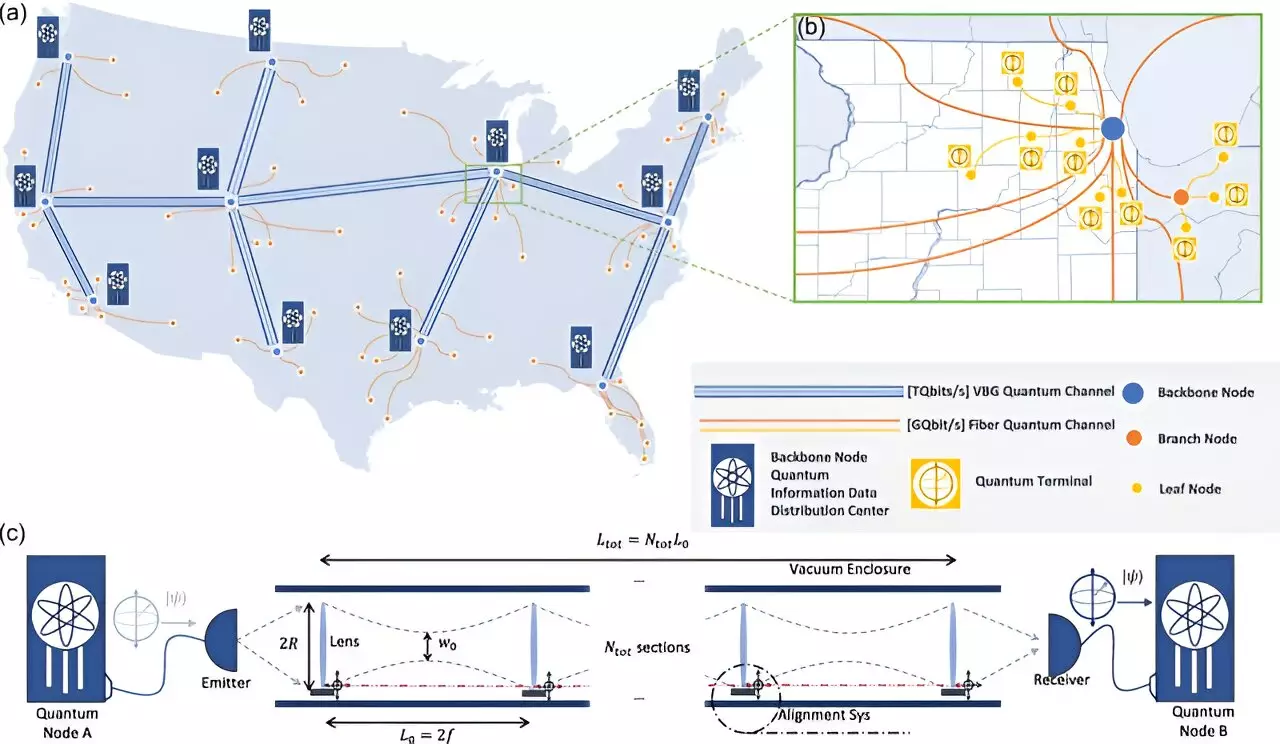In the rapidly evolving technological landscape, quantum computing stands out as a remarkable advancement, poised to revolutionize fields from cybersecurity to data processing. Central to its potential is the concept of the quantum internet—a network where multiple quantum computers collaborate, significantly enhancing their collective power. However, making this vision a reality presents formidable challenges, particularly in the quest to transmit quantum information over vast distances. Recent breakthroughs from the University of Chicago’s Pritzker School of Molecular Engineering (PME) suggest a compelling solution that marries innovation with practicality, paving the way toward a more interconnected quantum future.
Innovative Channel Design
The ingenious proposition from PME researchers revolves around creating long quantum channels utilizing vacuum-sealed tubes equipped with strategically placed lenses. These tubes, extending approximately 20 centimeters in diameter, promise to transmit quantum information over thousands of kilometers with impressive capacities, reportedly exceeding 10^13 qubits per second. This capability is a significant leap beyond existing quantum communication methodologies, which often struggle with data loss and attenuation. As Liang Jiang, a principal investigator on this project, notes, the envisioned network is not merely theoretical; it harbors vast potential for secure communications, distributed computing, and even sophisticated applications like synchronized clocks and advanced telescopes.
This innovative approach addresses a core issue in quantum communication—the fragility of qubits during transmission. Classical networking systems have proven inadequate, primarily due to their inability to preserve the delicate quantum states that define qubits. Jiang’s work highlights a crucial distinction: while classical systems can handle and relay classical data, quantum states require a dedicated infrastructure that can maintain their unique properties throughout the transmission process.
Building on Established Success
The ambitious idea of using vacuum tubes is inspired by existing technologies employed at the Laser Interferometer Gravitational-Wave Observatory (LIGO). At LIGO, extensive vacuum systems have proven effective in enabling the detection of gravitational waves by allowing photons to traverse long distances with minimal interference. This cutting-edge research serves as a blueprint for Jiang and his team, who aim to scale down these concepts for practical applications in quantum networks.
Notably, the PME researchers have identified that their vacuum tubes can operate efficiently under medium vacuum conditions, which are significantly easier to maintain than the ultra-high vacuum required by LIGO. This realization underscores both the ingenuity and practicality of their approach, making it a potentially feasible solution.
Combining Technologies for Enhanced Efficacy
The minds behind this revolutionary concept, including PME graduate student Yuexun Huang, are leveraging a fusion of established techniques—integrating the reliability of vacuum transmission with the precision of optical focusing. By strategically placing lenses at intervals along the tube, they aim to counteract the natural dispersion of photons over long distances. This method promises to retain the integrity of the quantum states being transmitted, a critical component in enabling successful quantum communication.
The ambitious plan does not merely stop at theoretical outlines. Researchers are now laying the groundwork for practical experiments and larger-scale implementations. Collaborators from Caltech emphasize that while the engineering hurdles are significant, they are not insurmountable. Initial tabletop tests will serve as a stepping stone toward using the expansive vacuum infrastructure at LIGO to optimize lens alignment and beam stability over considerable distances.
Contextualizing the Significance
The significance of achieving reliable long-distance quantum communication extends far beyond mere technological achievement. It embodies the promise of a future where secure data transmission is not only feasible but indispensable. As quantum computers become more adept at processing complex data and executing tasks that classical computers struggle with, the need for an interconnected infrastructure becomes increasingly vital. The ability to pool resources across quantum systems can foster innovations in various domains, from cryptography to machine learning.
However, the journey to this transformational future will require more than just technological advances. It will necessitate interdisciplinary collaboration among physicists, engineers, and computer scientists. Equally important will be navigating the regulatory landscape and addressing public concerns about quantum technology’s implications for privacy and security.
Charting the Path Forward
The exploration of vacuum-sealed quantum channels represents a thrilling frontier in quantum computing. As researchers embark on the practical stages of their proposal, the potential for groundbreaking applications lurking on the horizon inspires optimism. If successful, not only could this technology redefine communication but it could also catalyze a broader digital renaissance—one that is equally formidable and exciting in its implications for society and the global economy. The quantum revolution is not merely on the horizon; it is being actively scripted by innovators today.

